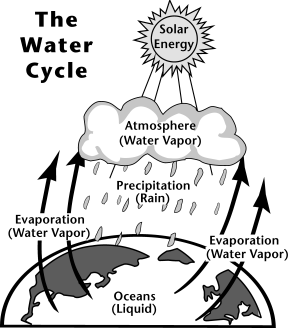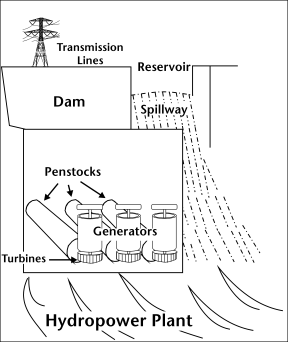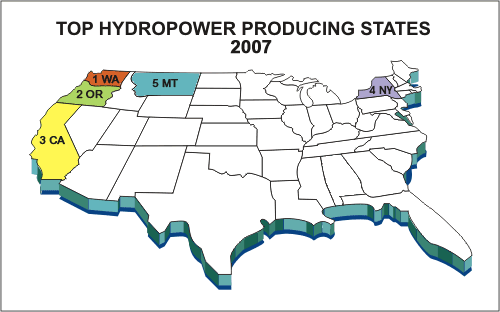|
Hydropower
as Fuel
See
also:
other
readings with assessment in Alternative Energy -- Wind
Energy -- Geothermal Energy -- Hydropower -- Nuclear Energy
--
see
Alternative Energy Basics
|
|
|
HYDROPOWER GENERATES ELECTRICITY
Of the renewable
energy sources that generate electricity, hydropower is the most
often used. It accounted for 6 percent of total U.S. electricity
generation and 71 percent of generation from renewables in 2007.
It is one of
the oldest sources of energy and was used thousands of years ago
to turn a paddle wheel for purposes such as grinding grain.
Our nationís first industrial use of hydropower to generate electricity
occurred in 1880, when 16 brush-arc lamps were powered using a water
turbine at the Wolverine Chair Factory in Grand Rapids, Michigan.
The first U.S. hydroelectric power plant opened on the Fox River
near Appleton, Wisconsin, on September 30, 1882. Until that time,
coal was the only fuel used to produce electricity. Because the
source of hydropower is water, hydroelectric power plants must be
located on a water source. Therefore, it wasnít until the technology
to transmit electricity over long distances was developed that hydropower
became widely used.
HOW
HYDROPOWER WORKS

Understanding
the water cycle is important to understanding hydropower. In the
water cycle -
- Solar energy
heats water on the surface, causing it to evaporate.
- This water
vapor condenses into clouds and falls back onto the surface as
precipitation.
- The water
flows through rivers back into the oceans, where it can evaporate
and begin the cycle over again.
Mechanical
energy is derived by directing, harnessing, or channeling moving
water. The amount of available energy in moving water is determined
by its flow or fall.Swiftly flowing water in a
big river, like the Columbia River  along the border between Oregon and Washington, carries
a great deal of energy in its flow. So, too,with water descending
rapidly from a very high point, like Niagara Falls in New York.
In either instance, the water flows through a pipe, or penstock,then
pushes against and turns blades in a turbine to spin a generator
to produce electricity. In a run-of-the-river system,
the force of the current applies the needed pressure, while
in a storage system, water is accumulated in reservoirs
created by dams, then released when the demand for electricity
is high. Meanwhile, the reservoirs or lakes are used for boating
and fishing, and often the rivers beyond the dams provide opportunities
for whitewater rafting and kayaking. Hoover
Dam, a hydroelectric facility completed in 1936 on the Colorado
River between Arizona and Nevada, created Lake Mead, a 110-mile-long
national recreational area that offers water sports and fishing
in a desert setting. along the border between Oregon and Washington, carries
a great deal of energy in its flow. So, too,with water descending
rapidly from a very high point, like Niagara Falls in New York.
In either instance, the water flows through a pipe, or penstock,then
pushes against and turns blades in a turbine to spin a generator
to produce electricity. In a run-of-the-river system,
the force of the current applies the needed pressure, while
in a storage system, water is accumulated in reservoirs
created by dams, then released when the demand for electricity
is high. Meanwhile, the reservoirs or lakes are used for boating
and fishing, and often the rivers beyond the dams provide opportunities
for whitewater rafting and kayaking. Hoover
Dam, a hydroelectric facility completed in 1936 on the Colorado
River between Arizona and Nevada, created Lake Mead, a 110-mile-long
national recreational area that offers water sports and fishing
in a desert setting.
WHERE
HYDROPOWER IS GENERATED
Over one-half
of the total U.S. hydroelectric capacity for electricity generation
is concentrated in three States (Washington, California and
Oregon) with approximately 27 percent in Washington, the location
of the Nationís largest hydroelectric facility Ė the Grand Coulee
Dam.

It is important
to note that only a small percentage of all dams in the United
States produce electricity. Most dams were constructed solely
to provide irrigation and flood control.
HYDROPOWER
AND THE ENVIROMENT
Some people
regard hydropower as the ideal fuel for electricity generation
because, unlike the nonrenewable fuels used to generate electricity,
it is almost free, there are no waste products, and hydropower
does not pollute the water or the air. However, it is criticized
because it does change the environment by affecting natural
habitats. For instance, in the Columbia River, salmon must swim
upstream to their spawning grounds to reproduce, but the series
of dams gets in their way. Different approaches to fixing this
problem have been used, including the construction of "fish
ladders" which help the salmon "step up" the dam to the spawning
grounds upstream.
SOURCE : ENERGY
INFORMATION ADMINISTRATION -- DEPARTMENT OF ENERGY -- KIDS HOME
PAGE
TEST
YOUR KNOWLEDGE OF THE MATERIAL
|

